|
A
Page-turner's survival guide
or how to make yourself an
invaluable friend to every pianist on earth
I suggested in one of my
previous articles
that there ought to be a place page turners could go to
complete their education; preferably at a music
conservatory where their achievements could be best
encouraged, closely monitored, the most opportunities
for practice, etc., but since no one has taken me up on
this yet I offer here a modest online tutorial for those
thrown suddenly into the fray who would like to enhance
their skills before the big night.
Some basics
| It is never
good to actually crash into the performer. Try
to sit far enough away that, while you can see
the music, you need not worry that a pianist's
sudden rush up or down the keyboard will earn
you a bruise that will hurt the next day.
Official concert position is so that the right
side of the performer is facing the audience. If
the piano lid is open the sound will thus
radiate in the direction of the patrons who have
agreed, by their presence, to accept the
consequences. This means that the page turner
should be seated on the pianist's left so that
he or she does not block the audience's view of
their idol. But you never know. Things may
function a bit differently for your setup. If
the piano is facing the opposite direction you
may have to sit to the pianist's right. It is
generally a good idea not to sit between the
pianist and the audience unless you are a really
good page turner and you think that at least
half the audience is there to see you. |
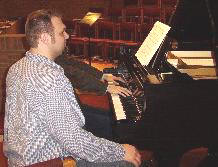
|
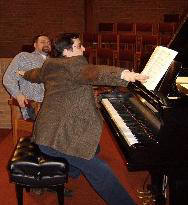 |
If you want to
be certain of your angle, ask the pianist to do
a couple of windmills while seated on the piano
bench. This will demonstrate the reach of their
arms and assure you that you are seated in a way
that they cannot possibly hit you. While seated,
that is. When you are actually engaging in a
page turn you will have to watch the situation
more closely. It wouldn't be a sport if there
wasn't any risk involved.
|
Actual page turning
If you are planning to make a life
study of this valuable skill this can be saved for our
next lesson. If you want to learn in a hurry, here is
what to do:
Some time approximating 5 to 10
seconds before it will be necessary to turn the page,
stand up. You should now be hovering a couple
of feet from the pianist, a little above his head. Not
your whole body, of course. If the piece is of
moderate to fast speed, stand
up when
the pianist has reached the
beginning of the last line.
Look for a nod from the pianist to indicate when to
turn the page. Most often, a pianist will want the
page turned just as he reaches
the last measure on the page, but this is a personal preference.
You may wish to ask the pianist about this. The
general rule of measurement applies if the pianist
does not nod, being a little busy with other things,
or has his own maverick way of doing things. I tend to
look down for a second so I don't get dizzy when I see
the page being turned. When I look up, I hope to see a
new page, having grown tired of the last one. When you
have turned the page, from the top of the page, being careful not to get your torso
too close to the pianist, and when you are certain
that you have only turned the desired number of pages
(generally being one at a time),
sit down, and politely wait your turn for the
next time. Lather, rinse, repeat as often as
necessary.
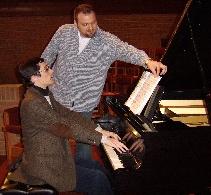
Figuring out where you are in the
music if you can't read music
Now, this last description presuppose a
few things. One is that you can read music. If you are
able or nearly able to play what the pianist is playing
you do not need my tutorial; you can inquire about
becoming my teaching assistant. If you have absolutely
no idea what the symbols on the page mean at all, don't
panic. Here are some things you can do:
Follow the words. If someone is singing words to
the piece you are to play, then you can simply follow
the text. I had a very good time one evening last year
at a school concert listening to one young lady who
had been commandeered to turn pages for me at the last
minute busily counting the measures under her breath
(fairly loudly), obviously rather concerned lest she
miss the right moment to turn each page. Since it was
a choral concert, I wanted to tell her just to read
the words the choir was singing and not to worry
herself about it, but the concert had already started
and I had other things to do.
If the piece is not texted, or if the
text disappears for a moment, you can do several things.
One is to count measures, if you are reasonably musical
and have some idea of the beat. It will give you, if you
are accurate, some idea of where the pianist ought to be
on the page so you have some idea of when to stand up.
Standing up too soon will give the pianist the
uncomfortable sensation of being at a lesson; standing
up too late means you may miss your opportunity
altogether. Obviously this window varies with the speed
of the piece. If you are able to key in to the tempo of
the piece, you have the added benefit of communing with
the spirit of the music. It is a good idea not to count
out loud. Or to tap your feet. Or to look like you are
enjoying the music too much. Unless the performers are
not very good. Then a large part of their stock in trade
may be looking like they love what they are doing so
much that their audience will be too annoyed by their
cheesy grins to take much offense at the noises they
produce. In which case, you may join in.
Very often, a piece will be
rather picturesque on the page. A florid passage will
look that way. If the pianist runs up the piano, the
notes will get higher on the page. Actually, it
happens the other way around--first the notes tell the
pianist what to do and then he does it. What is important to spot are
landmarks. If there is a
sharp contrast between lots of thick, black notes
joined together like foosball players, or clustered in
a squadron, and then suddenly the page becomes
peaceful, you will be able to identify that spot when
you come to it and know where you are, which generally
contributes highly to a page turner's peace of mind.
Contrasts of loud and soft are also useful; you may
wish to memorize these few marks:
ff-very loud
f- loud
mf- medium loud (which, in a strange
twist, is actually less loud than just plain loud)
mp-medium soft (louder than just soft)
p-soft
pp-very soft
There are extremes at both ends,
made by adding more fs or ps to the
porridge, and these are the most useful marks to
notice anyway, especially when one extreme suddenly
dissolves into another. If there is a mark like "subito
pp" after some blustering around, that "suddenly
very soft" will tell you exactly when you get there.
Some other things to notice, if you have several
instruments, are when one of them has begun to play
again, or has just stopped playing; mark your spot
there. You can see it when the notes start to appear
on one of the other lines. All the ones that" have the
same line running through them are occurring at the
same time; that vertical line joins them all together.
You may wish to simply follow the
profile of the melody. Don't hum. If the pianist wants
to hum, that's his business. Many of the good ones do.
So do some of the worst members of the audience.
|
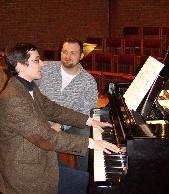
|
If you are really cagey, you can
follow the pianist's gaze as he makes his journey
across the page. If he is staring a little to his
left, then he is still on that page; you don't
need to panic just yet. If he is short enough you
might be able to make out when he is at the top of
the page. Despite their good looks, it is still
advisable to look at the music and not at the
pianists. |
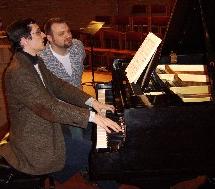
|
Matters of form and style
Some people would like to know why I've
asked that they stand up every time they are ready to
turn a page. If the page turns come in rapid succession,
the page turner may feel like she is playing "my bonnie
lies over the ocean" in front of an audience. But if you
don't stand up, you are liable, unless you are very
tall, not to be able to get your page to the other side
without nearly whacking the pianist on the side of the
head. You really need some height so you can turn the
page from the top, anyway.
Let me explain what happens if you turn
the page from the bottom. The pianist sometimes cannot
play his notes because moving his hands to the required
position means going through some of yours. This is why
you should really, at all times, permit the pianist full
range of motion, especially if you cannot read music
well, and don't really know that he won't suddenly
launch himself at the low end of the keyboard and catch
you off-guard.
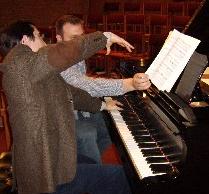
There is a well-known incident
involving a pianist--I don't recall whom--who was giving
a concert at Carnegie Hall. The page turner kept turning
the pages from the bottom. After a while, the frustrated
pianist said in a hoarse whisper, "from the top!"
Whereupon, the indignant page turner stood up and
flipped the entire score back to the beginning. This is,
of course, an alternate meaning to the phrase, "from the
top", but it is not usually a good idea to do this in
mid-concert unless you are absolutely sure that you are
starting over, as George Szell did once when the
audience for a Cleveland Orchestra concert set a new
world's record for coughs during the gossamer opening of
the overture to Tristan and Isolde.*
I have, in my
time, had to play passages in different octaves when I
was prevented from reaching the right one by my page
turner; I have turned back pages when two were turned
by mistake, or none was turned at all; once, the page
turner sat back down, unaware that he had turned to an
empty leaf between pieces and I had to finish the
piece from memory. I have also played through my page
turner's suit jacket, when I could see the note I
needed just before he blocked it. Pianists have ways
of getting the music played in spite of the obstacles,
much like a running back determined to score a
touchdown even if he has to bounce off of the entire
defensive line before he gets to the endzone.
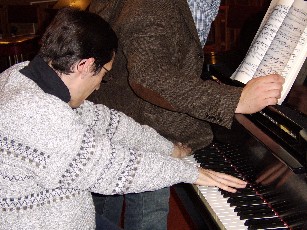
Intermediate Page-Turning
Here are a few
important exceptions to the normal flow of things.
Page turning rule #9
If you notice
that right hand page has a double bar at the end
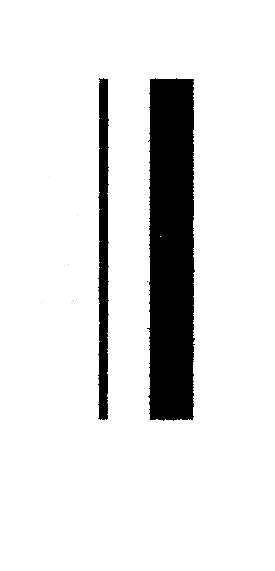 that
means the piece is over. There is no point in turning
to the next page; the piece will end with the end of
the page. When you see the double bar, you can let out
a sigh of relief (preferably inaudible), for your job
is temporarily over. that
means the piece is over. There is no point in turning
to the next page; the piece will end with the end of
the page. When you see the double bar, you can let out
a sigh of relief (preferably inaudible), for your job
is temporarily over.
If the piece
contains several movements (that is, separate pieces
that together are part of a larger work), those double
bars will still be in force. Not turning those pages
gives the pianist himself a chance to turn the page to
the next piece when he is good and ready; the
atmosphere from the last piece has a chance to
evaporate, and the pianist can control when he wants
to break the spell with an extraneous motion. We
pianists are a funny lot.
Important
exception to rule 9: if the page
contains said double bar, but it also has the word
"attacca" nearby, turn the page as you would
normally. "Attacca" means we are going to attack the
next movement without pausing in between. The next
sounds you hear will be a totally different piece,
but there won't be any time to quietly digest the
contents of the last one.
I'm going to
insert a bit of page-turning arcana here; there is a
mark known as V.S. or Volti Subito, which quite
literally means "turn the page quickly". This almost
never happens, and if you find the composer addressing
you, the page turner, directly, you should consider it
quite an honor. You should also be on your toes,
because there is very important information on the
next page that the pianist has to set his eyes on
pronto. As I said, you'll most likely never see this
mark, but if you do, you'll feel very proud of
yourself for recognizing it.
Now if you notice
that the pianist has a measure or two, or perhaps an
entire line, where he is not playing anything,
probably because some soprano has stolen the show; all
the notes are for her, but not for our poor
accompanist/hero, you should gracefully allow the
pianist to turn the page himself. This courteous
gesture allows the performers to assume control
themselves over when they are ready to look at the
next page; pianists do tend to have two perfectly good
hands which, when they are not busy pounding little
plastic levers, are just as good at turning pages as
the rest of us.
When you notice
that there is a universal rest (pause); that nobody is
making any musically required sound, and that the page
turn, should one occur, would be the only thing
audible in the concert hall, try to place it on one
side of the rest or the other to preserve the
atmosphere. If you have not been over that section
with your pianist beforehand, I recommend doing it
just before the rest. Sometimes I will instruct my
page turner to wait until after, confidant that I have
the next few bars memorized.
Turning a page backwards
There are cases
where it will be necessary to turn back to a previous
page, or perhaps to intentionally skip a few. When you
see a repeat sign it is generally too late to know
just how much music your pianist is going to have to
repeat, so you will want to watch carefully when you
see one of the following signs:
your standard "repeat" signs come
in pairs.
 The
idea is that you have to repeat everything in between
these two signs! The
idea is that you have to repeat everything in between
these two signs!
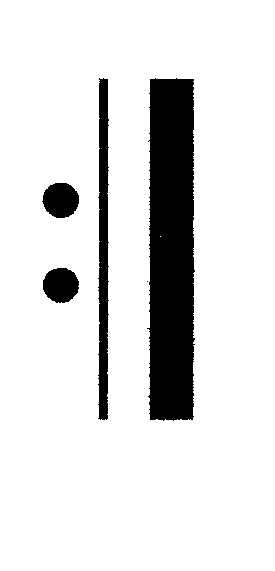
Note: if you can
absolutely prove that you did not see one of
these
 anywhere previous to
seeing one of these anywhere previous to
seeing one of these
 , then you are to go back to
the beginning of the music. "Sonatas" generally do
just that with the first several pages of their
opening movement. , then you are to go back to
the beginning of the music. "Sonatas" generally do
just that with the first several pages of their
opening movement.
These are signs
you will definitely want to remember for later, for,
perhaps several pages down the road, you will need to
go back to that precise spot in the music. If you want
to pass your exam so you can enter the advanced class,
be aware that the test most certainly includes at
least one of these. If you are not in the mood for
such a workout, you'll certainly want to avoid pieces
with the word "Sonata" in them. These always have at
least one very prominent repeat in them, unless the
pianist has decided to ignore it. If the pianist has
not told you in advance whether he is going to take
the repeat you may wish to panic when the moment
arrives; be prepared to turn the page in either
direction, or both at once.
You can
immediately establish yourself as an expert
page-turner when turning pages for a piece called
"Sonata" by asking the pianist if he plans to
repeat the first movement exposition. Also, if one
of the movements is labeled "Scherzo" you will
probably have to return to the beginning of the
movement when you get to the end (D.C. means go
back to the beginning) unless the publishers have
written it out for you. (D.S. is that other kind
of nasty sign that means go back to the sign we
discussed earlier (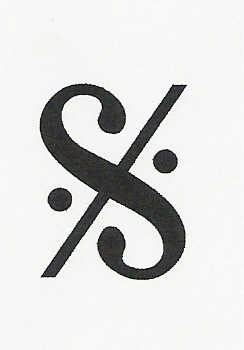 ) and proceed from there.) ) and proceed from there.)
Some other things
you will need to know to pass the advanced class: many
choral publishers like to put repeat signs only a
measure or two after the page turn which means you
will have to turn the page forward and then, before
you have had time to blink once, turn back to that
doggoned inverted repeat sign. But if you want to get
into the advanced class you'll have to sign up for it.
Here is our last handout, a handy guide to all the
signs that make page-turning life interesting. It is
always good to scan the music for these in advance
since all of our most aerobic turning will be done in
response to these; some page-turning divas like to
clog their routines with these kinds of things just to
show off and hog stage time. If you get a chance, ask
your pianist about the "road map" for each piece in
advance, or if she is "taking the repeats". If you
never get a chance to do this in real life you can
still sound like a dandy at cocktail parties by
dropping these phrases once in a while.
Really
Nasty Signs (in order of nastiness)
D.C. al
fine -- Go back to the beginning
of the movement; the pianist will now play the music a
second time until he is either too worn out to continue,
or he sees the Italian instruction for "finish"--the
word "fine", which is pronounced fee-nay,
D.S. al
fine -- This one is a bit harder. It
requires you to look for a little symbol that could pass
for the coat-of-arms of an ancient clan of warriors,
namely--

if you are on the
lookout for this sign at all times, you'll spot it on
the first pass. Several pages later you will need to
know where this sign is. In addition to knowing what
page to flip back too, you should remember its location
on that page, in case the pianist is looking lost and
you need to direct her to that location. You will
instantly become recognized internationally by the guild
of page-turning cognoscenti.
The
pianist will now continue playing from the point of this
sign until the conclusion of the piece, "fine".
and of course, the
triple-axle of the page-turning world:
D.S. al
coda This works the same way as the
sign noted above, only, now instead of merely continuing
on from the point of the  sign until we've reached the end, there
will now be an additional sign until we've reached the end, there
will now be an additional
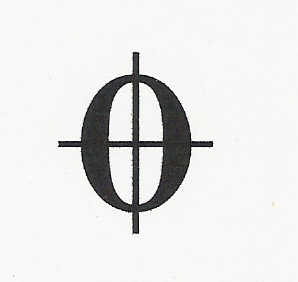 coda sign, which means we will now
skip all of the music in front of us and proceed
directly to the coda, which is the part that the pianist
didn't get to play earlier because we were too busy
skipping back to the coda sign, which means we will now
skip all of the music in front of us and proceed
directly to the coda, which is the part that the pianist
didn't get to play earlier because we were too busy
skipping back to the
 sign. sign.
the page turner's
"triple Salchow" is a small variation on this, called
the D. C. al coda. I trust you can
figure out how this works. It will be on the test.
(By the way, if your
services are required for the accompanist of a singer
doing something from an opera, there may well be some
places in the music where the performers have chosen,
for reasons of their own, to cut whole sections out of
the music. This is generally marked with an elegant
pencil slash through the score. Try to find the next
similar-looking slash as best you can.)
to sum up: D. C. and D.
S. mean to go back; D.C. means back to the beginning of
the movement, D.S. to a particular spot marked with a
sign. (D.C. literally means da capo, or "from the head",
where D.S. or dal segno, means "from the sign") A coda
sign means to skip ahead to another spot marked with an
identical sign bearing the word "coda", which,
incidentally, means "tail" as in "tail end", although
some composers can go on for quite some time once
they've reached it.
Speaking of which, we have reached the
coda of this little article, so I'll leave you with one
nice thought.
Page-turning is a
high stress job and requires years of steady effort to
master; it is good to start out as an apprentice and
work your way up. If you are lucky, perhaps you will
be acknowledged in the program, or even asked to do
interviews on public radio.
In the meantime, you will
get a nice seat for the concert.
|